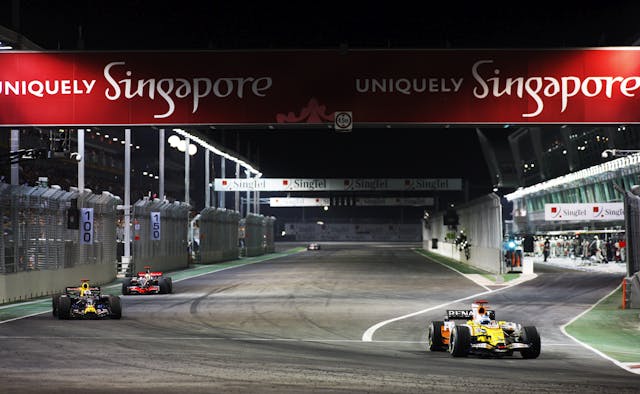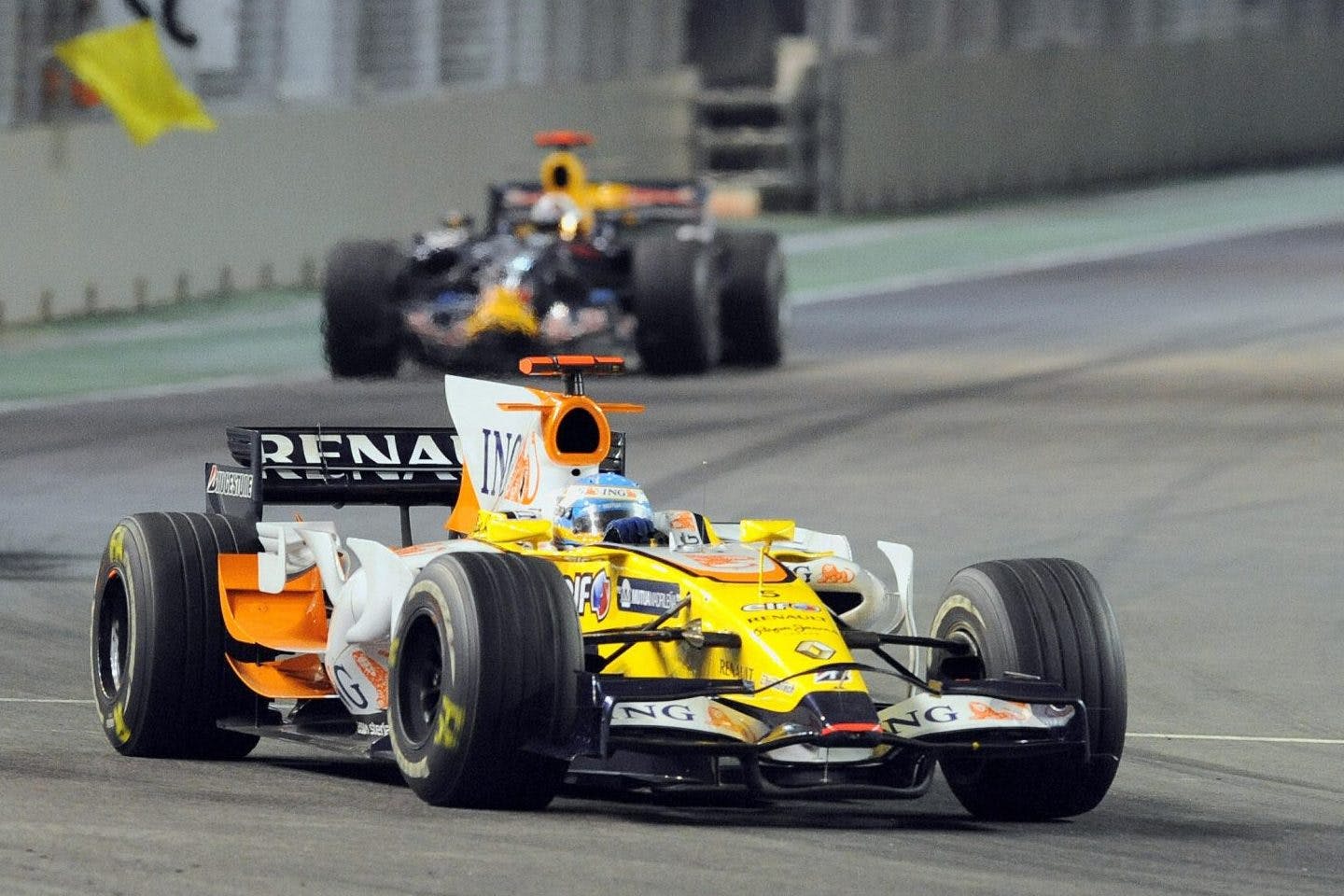Media | Articles
Scandal tainted Formula 1’s first night race in 2008
The Singapore Grand Prix is the slowest race on the Formula 1 calendar, around the tight and twisting Marina Bay street circuit. Still, in recent years, the race has produced rather compelling competition.
In 2008, Formula 1 held its first-ever night race at the circuit, the streets of Singapore illuminated by more than 1600 lights. On the surface, it appeared as though the grand prix went according to plan. Smooth and successful. And by holding the race at night, it also proved that races in Asia could be staged to satisfy F1’s demanding European fan base.
Nearly a year after Singapore’s victor was crowned, a disgruntled driver and an official investigation revealed one of the largest scandals in the sport’s history.

Twelve laps into the race, Fernando Alonso was dead last. Twenty-one laps later he assumed a lead. Though the change in fortune was quick, it took nearly a year to uncover and explain Alonso’s astonishing ascension in the race.
For the Spaniard, 2008 marked a year of treading water. After a spectacular falling out with McLaren following just one season together, he returned to Renault, where he won the world championship in 2006. But things had not gone as either party planned.
Marketplace
Buy and sell classics with confidence
The team was a shadow of its former self. It hadn’t won a race in nearly two years, and several fourth places in 14 races served as the lacklustre highpoints to a season-long struggle with a difficult car. Still, the French manufacturer was not to be discouraged. Changes to the car had made it competitive by the time teams arrived in Singapore. Only a mechanical problem in qualifying relegated Alonso toward the back of the pack.
To overcome the poor starting position, Renault’s executive director of engineering Pat Symonds had a plan. Symonds—one of F1’s most experienced and astute operators—always had a plan. On lap 12, Alonso became the first car in the field to stop for new tires and more fuel. He re-joined dead last and, seemingly, without a chance to move forward on such a tight track.
Two laps later, Fernando’s fortunes changed.
Renault teammate Nelson Piquet Jr crashed at Turn 17. Eagle-eyed spectators noticed that the Brazilian rookie spun at that corner on the warm-up lap, but managed to keep the car away from the wall. The second incident was a much more comprehensive—and significant—crash.
The heavy impact wiped the right rear-wheel off the Renault. Piquet was uninjured, but the site of the wreck didn’t have a crane to salvage stricken racers. Cue the safety car. The yellow prompted drivers to change tires and refuel, as they sought to minimize the time lost during a pit stop.
When the pitting cars re-joined, they were behind Alonso, who was now in fifth place.
Crucially, two of the cars ahead—Nico Rosberg and Robert Kubica—had refuelled before the pit lane was officially open, meaning they had to serve 10-second penalties. The other two, Jarno Trulli and Giancarlo Fisichella, had yet to make their stops.
On lap 33, Alonso inherited the lead, where he remained for the rest of the race. The win was not without a challenge, as Alonso held off a feisty Nico Rosberg to take his 20th F1 victory.

It seemed as though Alonso’s win was the result of a canny, tactically astute drive, helped by a substantial slice of good fortune. But as can often be the case in Formula 1, there was a lot more to it than that.
Beyond the actions of Renault team chief Flavio Briatore, driver Piquet, and engineer Symonds, it’s almost impossible to know exactly what happened.
Briatore was a man under pressure. Renault had underperformed since its title-winning 2006 season and rumours were swirling that the management was considering pulling the team out of F1 altogether. A win or two would certainly help Briatore when it came to convincing CEOs in the corporation’s boardroom.

Piquet, in his rookie F1 season, was keen to be retained by Renault for 2009. Piquet later stated that Briatore was pressuring the young driver by refusing to confirm a lineup for the following season.
Despite the friction, Piquet was retained by Renault for a second season. But after some lacklustre performances, he was sacked following the summer’s Hungarian Grand Prix, in 2009.
Then, the bombshell. Piquet claimed that Briatore and Symonds asked him to crash on purpose to help Alonso. He said, “After ensuring I was on the designated lap of the race, I deliberately lost control of my car. I did this by pressing hard and early on the throttle. As I felt the back end of the car drifting out, I continued to press hard on the throttle, in the knowledge that this would lead to my car making heavy contact with the concrete wall …”
This was corroborated by Piquet’s in-car telemetry, which showed that rather than coming off the accelerator as the car began to spin, the Brazilian continued accelerating.
He was so aggrieved that he wrote to the FIA, Formula 1’s governing body, blowing the whistle on his antics at the previous year’s Singapore Grand Prix. He revealed that his crash was deliberate and orchestrated by the team, throwing the race to Renault and Alonso’s advantage.

Following a lengthy investigation into conspiracy and race fixing, Briatore was banned from taking part in FIA-sanctioned events for life. Symonds was banned for five years. Both left Renault. Their bans were reversed after an appeal.
Meanwhile, Alonso claimed to know nothing about the Piquet crash plan. The FIA also ruled he was innocent, though many F1 notables (including future teammate Felipe Massa) thought this might be a stretch. Piquet even claimed that without knowing there was going to be a safety car, Alonso’s strategy of stopping on lap 12 made no sense.
The debacle was an unfortunate sour note to taint a brilliant inaugural Singapore Grand Prix, and a marvellous maiden voyage under the lights. It’s a shame the only thing that people will remember is a rather seedy race-fixing scandal.

Check out the Hagerty Media homepage so you don’t miss a single story, or better yet, bookmark it.















